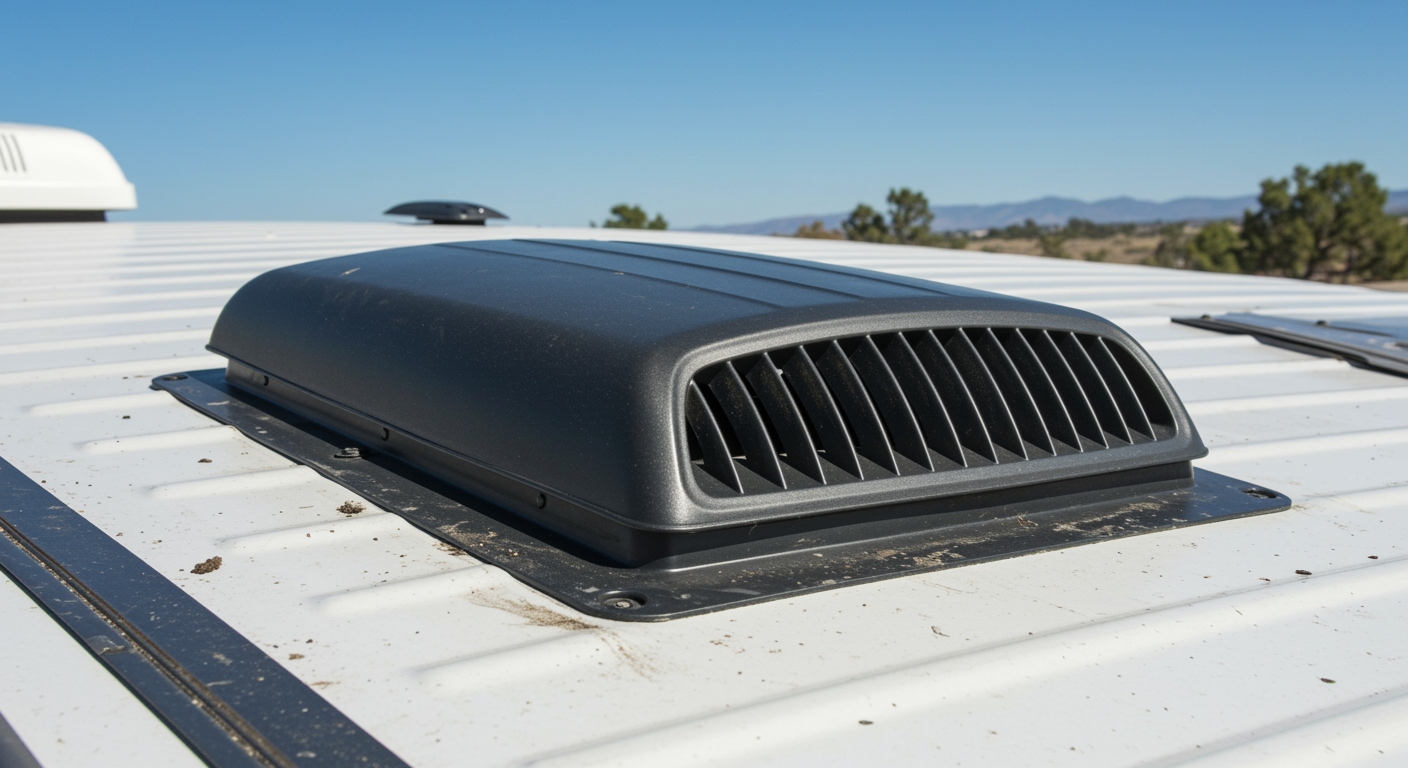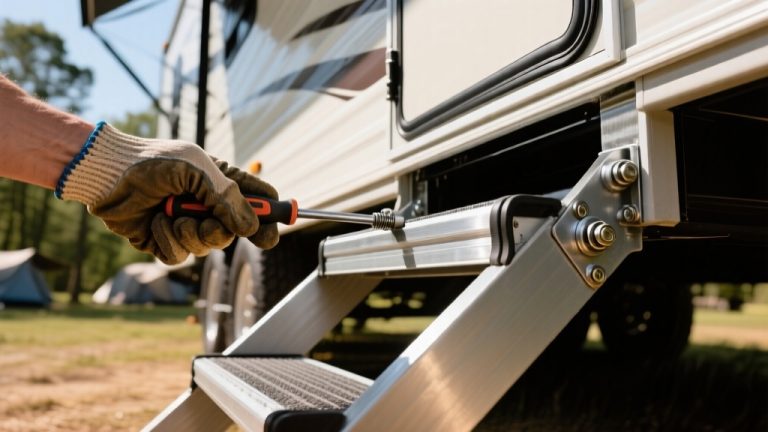To replace your RV vent cover, start by gathering tools like a screwdriver, drill, and putty knife. Identify your vent type and size, then safely access the area. Remove the old cover by unscrewing fasteners and scraping off sealant. Clean the surface before centering the new cover and securing it with brackets and screws. Finally, check for leaks and smooth operation of the vent mechanism. There’s more to guarantee proper installation and maintenance ahead.
Key Takeaways
- Measure the vent size and identify the type before purchasing a compatible replacement cover.
- Safely remove the old vent cover by unscrewing fasteners and using a putty knife to detach it.
- Clean the area around the vent thoroughly to ensure proper adhesion of the new cover.
- Secure the new vent cover by aligning it with the mounting points and fastening it with screws and brackets.
- Apply sealant around the edges to prevent leaks and conduct a water test to ensure proper installation.
Tools and Materials Needed for the Job
When replacing an RV vent cover, you’ll need a few crucial tools and materials to get the job done efficiently.
Start with basic hand tools like a screwdriver and a drill for removing screws. A putty scraper helps you remove the old sealant effectively. It’s important to keep in mind that vent covers provide essential ventilation for your RV, ensuring a safe and comfortable environment.
Begin with essential hand tools, such as a screwdriver and drill, to easily remove screws and old sealant.
You’ll also require a new RV vent cover tailored to fit your specific vent opening. Don’t forget screws and sealant, such as EPDM lap sealant, to guarantee a watertight fit. Additional items like tape can assist in securing components during installation. It’s essential to have safety equipment like gloves to protect against sharp edges.
Make sure your tools are compatible with the screws used on your RV, and always follow detailed guides for a successful replacement.
Identifying Your RV Vent Type
To successfully replace your RV vent cover, you need to identify the type of vent your vehicle has, as different models require specific covers.
Start by measuring your vent size; most standard RV roof vents are 14″ x 14″ or 9″ x 9″. Check the manufacturer, as common options include Ventline, Jensen, and Elixir.
Determine if your vent is a powered type or a regular lid, as this affects compatibility. Also, note the hinge mechanism on your original cover; it must match the replacement to guarantee proper fit. Additionally, consider the complete non-powered 14 inch x 14 inch high profile RV vent installation kit, which is suitable for various RV roof types.
Consider your vent cover’s material and design, as these factors impact durability and functionality.
Finally, verify compatibility with any vent fans installed in your RV.
Preparing for the Removal Process
Preparing for the removal process of your RV vent cover involves several critical steps to guarantee a smooth and efficient replacement.
First, gather the necessary tools: a screwdriver for removing screws, a drill if new brackets are needed, and a new vent cover that fits your existing opening. Don’t forget screws, washers, and the correct sealant to prevent leaks. Additionally, consider researching the 360 Siphon RV Vent Cap to enhance odor control.
Clean the area around the vent to confirm proper adhesion for the new cover. Assess your vent type, as different models require specific approaches.
Confirm safe access with a sturdy ladder and consider using safety gear, like gloves and goggles. Plan for weather conditions, avoiding replacement during heavy rain or strong winds to confirm a safe and effective installation.
Steps to Remove the Old Vent Cover
Before you start removing the old vent cover, gather your tools, including a screwdriver, drill, and putty scraper. Make certain the RV is on level ground and safely access the vent area, removing any interior components that obstruct your path. Signs its time for a new vent cover indicate that you may need to replace the old cover if you notice any cracks or poor airflow. Taking photos during this process can help you remember how to reassemble everything later.
Prepare for Removal
Removing the old vent cover requires careful preparation to guarantee a smooth process. First, gather your tools: a screwdriver, drill, putty knife, long nose pliers, and metal cutter. You’ll also need materials like a new vent cover, screws, sealant specific for RV materials, mineral spirits, and paper towels.
Clear the area around the vent and remove any obstructions, ensuring the surface is dry and clean. Wipe down the area with a dry rag and check for sealant residue. It’s important to thoroughly clean the area to ensure a proper bond for the new vent cover.
Prioritize safety by wearing gloves and maintaining stable footing on the RV roof, using a harness if necessary. Finally, inspect the vent’s condition for damage or leaks, and confirm the replacement cover’s compatibility before proceeding.
Detach Old Components
To detach the old components of the RV vent cover, start by ensuring you have the right tools at hand, including screwdrivers and a drill.
First, access the interior by removing trim rings and crank handles.
Next, head outside and secure a safe ladder before unscrewing the fasteners holding the vent cover. If screws are stuck, drill out their heads for easier removal. Drilling out screw heads can save you time and prevent damage to the surrounding area.
Use a putty knife to carefully loosen and remove the old sealant around the cover.
Once the fasteners are out, gently pry the cover off. If it’s an electric vent, disconnect any electrical wiring.
Finally, inspect the vent opening and surrounding roof for damage before cleaning the area thoroughly, preparing for the new installation.
How to Properly Dispose of Old Vent Components
When you’ve removed the old vent components, it’s essential to take into account their proper disposal. Check for local recycling options to guarantee you’re disposing of materials responsibly, and if recycling isn’t feasible, follow safe landfill methods. Always prioritize environmentally friendly practices to minimize waste, and remember to dispose of putty and sealant in accordance with local regulations to avoid environmental harm.
Recycling Options Available
Recycling old RV vent components not only supports environmental sustainability but also contributes to resource conservation.
When you replace your vent cover, consider disassembling it into its individual parts, such as polycarbonate plastic, metal components, and rubber seals. Many municipalities have recycling centers that accept these materials, including specialized plastic and metal recycling facilities. Additionally, the 360 Siphon’s design is made from high-quality polycarbonate plastics, making it a recyclable option when disposed of properly.
Make certain you clean the parts of dirt and debris, then sort them according to material type. Verify local guidelines to make certain proper disposal and maximize recycling potential.
Safe Disposal Methods
After considering recycling options for old RV vent components, it’s important to focus on safe and responsible disposal methods for those parts that can’t be reused or recycled. Here’s a quick reference table to guide you:
| Disposal Method | Description | Notes |
|---|---|---|
| Landfill Disposal | Common option for non-recyclable parts. | Check local landfill rules. |
| Specialized Waste Facilities | Facilities for construction waste, including RV parts. | Research local options. |
| Donation or Repurposing | Consider donating usable parts. | Contact local charities. |
| Hazardous Waste Facilities | For hazardous components, if applicable. | guarantee proper handling. |
| Community Clean-up Events | Participate in events for responsible disposal. | Check local schedules. |
Always consult local regulations and guidelines for safe disposal practices. Proper disposal is crucial as it prevents issues like clogged RV sewer vents that can arise from improperly discarded materials.
Installing the New Vent Cover
To install the new vent cover, start by centering it directly over the vent opening. Verify it aligns with the vent’s mounting flanges for a secure fit. Use a marker to mark the mounting points on the roof. Adjust the cover as necessary, double-checking that everything is aligned properly. Once you’re satisfied with the positioning, gather your screws and prepare for fastening. It’s vital to have the correct vent cover that matches your RV’s specifications to guarantee ideal airflow and ventilation. Additionally, remember that installing brackets is necessary to secure the cover properly. Before moving to the next steps, confirm that the area is clean and free of debris, which will help in achieving a proper seal later on.
Securing the New Vent With Mounting Brackets
Begin by preparing your tools and materials for securing the new vent cover with mounting brackets. You’ll need a screwdriver, drill, carriage bolts, and a pencil or Sharpie, along with mounting brackets, flat washers, lock washers, hex bolts, and hex nuts.
First, clear the roof vent frame of debris. Mark the bracket slots where they align with the vent cover’s mounting flange. Position the brackets at the outside corners for stability, ensuring they align with the vent cover holes. Remember to check the ceiling and roof condition before starting the installation process to ensure there are no cracks.
Drill holes through the frame where marked, then secure the brackets using screws or bolts. Finally, place the vent cover over the carriage bolts, fastening it with washers and nuts, and check for proper operation before completing.
Adding or Reinstalling the Fan Assembly
Before adding or reinstalling the fan assembly, you need to carefully remove the existing unit, noting how the wiring connects. Verify each connection to confirm compatibility and proper function once the new fan is in place. This step is essential for achieving peak performance and safety in your RV’s ventilation system. Additionally, consider using a new RV vent with fan for improved cost efficiency and functionality in your setup.
Fan Assembly Removal Process
Removing and reinstalling the fan assembly is essential for maintaining your RV’s ventilation system. First, disconnect the power by removing the battery’s negative terminal or switching off the power supply. Carefully climb onto the RV’s roof using proper safety equipment. Next, use a plastic squeegee or putty knife to remove the sealant around the vent. Gently pry the vent assembly away from the roof with a putty knife. Identify and safely remove the screws holding the fan in place using an impact driver. Remove any leftover butyl tape, and store the old fan assembly and parts securely. Finally, inspect and clean the area before proceeding with the installation of the new fan assembly. Properly functioning RV roof vents are critical for preventing moisture buildup and ensuring air quality within your RV.
Wiring Connections Verification Steps
Once you’ve reinstalled the fan assembly, verifying the wiring connections is essential to guarantee proper functionality and safety. Start by ensuring your RV’s 12V DC system is understood, identifying a dedicated circuit for your fan assembly to prevent overloads. Check the wire gauges; they must meet the fan’s power requirements. Connect the positive wire from the fan to the 12V DC system and the negative wire to the grounding system. After connecting, test all electrical connections for security and functionality. Additionally, ensure that the fan assembly is correctly integrated into the powered roof vent to optimize its performance. Manage wires carefully by bundling them and using zip ties to avoid entanglements. Finally, conduct a thorough test of the fan’s performance and verify that all systems operate within safe parameters.
Final Checks for Functionality and Leaks
As you complete the installation of your new RV vent cover, it’s crucial to conduct final checks for functionality and leaks to guarantee everything operates smoothly.
Start by inspecting the vent opening, confirming it’s clear of debris and old sealant. Next, verify that the new vent cover fits snugly and aligns properly with brackets. Finally, operate the vent mechanism multiple times to confirm smooth opening and closing.
Inspect the vent opening for debris, ensure a snug fit of the new cover, and test the mechanism for smooth operation.
- Apply sealant around the edges of the vent cover to prevent leaks.
- Conduct a water test by spraying water over the vent to check for leaks.
- Inspect the gasket for any signs of wear or damage, confirming a tight seal. Additionally, ensure all components are in good condition before proceeding with your new replacement cover.
These checks will help verify your vent cover functions effectively and remains leak-free.
Maintenance Tips for Your RV Vent System
To keep your RV vent system in top condition, regular maintenance is vital. Begin with frequent inspections of your vent covers for damage or wear. Clean the vents regularly to guarantee unobstructed airflow, as debris can hinder ventilation. Regular cleaning is necessary due to the exposure to heat, rain, and dust, so ensure to incorporate this into your maintenance routine. Lubricate moving parts to assure smooth operation and replace any worn-out components promptly to avoid leaks. Seasonal maintenance is significant; check seals around the vent covers for integrity and reapply sealant as necessary. Consider upgrading to energy-efficient vent covers or installing vent fans to enhance airflow. Address common issues like leaks and clogged openings immediately to preserve your RV’s comfort and prevent moisture buildup.
Frequently Asked Questions
How Often Should I Replace My RV Vent Cover?
You should assess your RV vent cover regularly, ideally every six months.
Depending on environmental factors and usage, they might last several years, but harsh weather can shorten this lifespan.
Look for signs like cracks, leaks, or discoloration, which indicate it’s time for a replacement.
Incorporating vent cover checks into your routine maintenance will help you catch issues early and guarantee your RV remains protected and ventilated effectively.
Can I Replace the Vent Cover Without a Fan?
Yes, you can replace the vent cover without a fan.
Just make sure you have the correct tools and a replacement cover that fits your vent size.
Remove the old cover by unscrewing it and clean the area before installing the new one.
Secure it properly with screws and sealant to prevent leaks.
Regularly check for any signs of wear or damage to maintain your RV’s ventilation system effectively.
What Tools Are Essential for This Replacement Job?
When tackling this task, you’ll need a toolbox brimming with essentials, like a screw gun and #2 Phillips and square bits to handle screws.
A drill might come in handy for new holes, while long nose pliers help manage small parts.
Don’t forget your replacement vent cover, screws, sealant, and possibly a ladder for safe access.
Accurate measurements with a tape measure guarantee you fit everything perfectly, like a puzzle piece in its spot.
Are There Specific Vent Cover Sizes for Different RV Models?
Yes, there are specific vent cover sizes for different RV models.
Most commonly, RV roof vents measure 14” by 14”, but you might also encounter 9” x 9” covers for pop-up campers.
It’s crucial to measure the vent opening accurately before purchasing a replacement.
Additionally, always check for compatibility with your RV’s hardware and manufacturer specifications to guarantee a proper fit.
This helps avoid installation issues and guarantees peak functionality.
How Do I Know if My Vent Cover Is Damaged?
Imagine your vent cover as a shield protecting your RV. If it’s cracked, brittle, or warped, it’s time to assess damage.
Look for visible cracks, loose screws, or gaps where water or dust might sneak in. If your RV feels stuffy and humid, that’s a sign of poor ventilation.
Regular checks can save you headaches later, so don’t ignore these signs; your RV’s comfort and integrity depend on it!
Stay Ahead of the Elements: Maintain Your RV Vents
Replacing your RV vent cover is like giving your home on wheels a refreshing change. By following the steps outlined, you guarantee that your RV stays comfortable and protected from the elements. Regular maintenance will keep your ventilation system functioning at its best, allowing you to enjoy every journey without worry. So, take the time to check your vents periodically; they’re the unsung heroes that keep your adventures vibrant and enjoyable. Safe travels.




